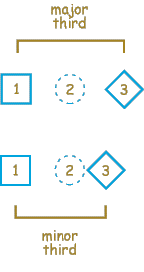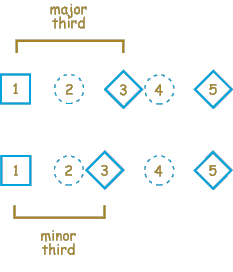Major
& Minor Triads
Major
and Minor Triads
Major and minor triads are simple, consonant chords, containing
three tones arranged in one of two ways. They are the primary
harmonic building blocks of tonal music.
Constructing
Triads
Triads are constructed within the context of scales. To construct
a triad, first pick one tone of the scale as the starting
point. Taking that pitch as your first tone, count upwards
and take the third and fifth pitches you come to as the other
two pitches of the triad. For example, if you start with the
second pitch of a scale, the triad based on that pitch will
also include the fourth and sixth pitches of the scale.
Video
Example 1: The beginning of a major scale then a triad
consisting of pitches two, four and six
If triads are formed on the basis of the major, harmonic
minor, and melodic minor scales, then these triads will be
of four types: major, minor, augmented, and diminished. (You
can read more about augmented and diminished triads in the
Sonic Glossary entry Third.)
Here we will be concerned only with major and minor triads,
which make up the majority of triads formed on the basis of
the scales of tonal music. In both major and minor triads,
the interval between the first and the fifth notes counted
off is always a perfect fifth. The only difference between
major and minor triads is in the third note. In the major
triad it forms a major third with the first note, and in the
minor triad a minor third.
Rather than continuing to talk explicitly about the tones
of a triad in terms of how they are counted off from the scale,
from now on we will use the standard terms for them: the root,
the third, and the fifth.
As major and minor triads are the primary chords used in
tonal harmony, let's look carefully at each one.
The
Major Triad
The simplest way to construct a major triad is to take the
tonic (that is, the first note) of a major scale as the root
of the triad. The third and fifth notes of the scale will
then form the third and fifth of the triad.
Video
Example 2: Construction of a major triad
The
Minor Triad
Likewise, the easiest way to construct a minor triad is to
take the tonic of a minor scale as the root of the triad.
Again, the third and fifth notes of the scale will then form
the third and fifth of the triad.
Video
Example 3: Construction of a minor triad
At the moment it suffices to think of this (taking the tonic
of the scale as the root of the triad) merely as a convenient
way of generating major and minor triads. Starting with Lesson
5, however, triads constructed in this way will come to have
a special importance. Such triads are called tonic triads.
Just as the tonic note of the scale is like a home base among
the pitches, so the tonic triad is like a home base among
the harmonies.
Telling
the Difference Between Major and Minor Triads
Just as the key to telling the difference between major and
minor scales was focusing on the third note of the scale,
so the way to distinguish major and minor triads is to listen
for the third of the triad. To help focus on the interval
between root and third, we'll take away the fifth for now,
just listening to major and minor thirds as simultaneous intervals.
Often we call the type of third the quality of the third;
in this case the quality of the third will either be major
or minor. Use the examples below to recall the difference
from Lesson 1. If
necessary, repeat them a few times; refresh your memory until
you feel that you can tell the difference reliably. If this
really presents problems, you should review Lesson
1 before proceeding.
Graphic Example 1: Major third and a minor third

Audio
Example 1: Major third
Audio
Example 2: Minor third
Now let's add the fifth back in to make complete triads.
Remember, major and minor triads with the same root have the
same fifth. Even with the fifth back, try to focus on the
quality of the third between the root and the third. Again,
listen repeatedly until you feel confident that you can tell
the difference. If necessary, go back and listen to the thirds
alone again.
Graphic Example 2: Major traid and a minor triad

Audio
Example 3: Major triad
Audio
Example 4: Minor triad
Once you feel confident in your ability to distinguish between
the two examples above, enter the training environment for
major and minor triads. Use this environment until you feel
that you have gained a solid ability to tell major and minor
triads apart.